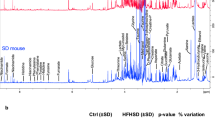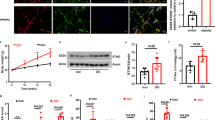Abstract
Background:
Surfactant protein-D (SFTPD) is a component of the lung innate immunity that enhances clearance of pathogens and modulates inflammatory responses. An inverse association of putative, lung-derived circulating SFTPD with obesity has been reported but no information is available concerning possible SFTPD gene expression in human adipose tissue.
Methods:
SFTPD gene expression was analyzed in human omental (OM; n=156) and subcutaneous (SC; n=106) adipose tissue, and in isolated fat cells (n=12) in association with measures of obesity and glucose tolerance.
Results:
SFTPD gene was expressed in human adipose tissue and adipocytes. This expression was decreased in OM and SC adipose tissue from obese subjects with (−47%, P<0.0001; and −37%, P=0.048) and without (−34%, P=0.001; and −22%, P=0.08; respectively) type 2 diabetes when compared with the control group. Indeed, OM SFTPD was inversely associated with body mass index (r=−0.33, P<0.0001), percent fat mass (r=−0.36, P<0.0001), waist perimeter (r=−0.26, P=0.002), diastolic blood pressure (r=−0.21, P=0.018) and fasting glucose (r=−0.21, P=0.012); and positively linked to the expression of insulin receptor substrate 1 (IRS1; r=0.25, P=0.004), perilipin A (PLIN; r=0.38, P=0.007) and fatty acid synthase (FASN; r=0.36, P<0.0001). Accordingly, increased SFTPD (4.5-fold, P=0.02) was detected in isolated adipocytes when compared with the stromal-vascular cell fraction, in parallel to IRS1, FASN and PLIN.
Conclusions:
Both OM and SC adipose tissue (mainly mature adipocytes) express SFTPD. This expression decreases with obesity and impaired glucose tolerance.




Similar content being viewed by others
References
Despres JP, Lemieux I . Abdominal obesity and metabolic syndrome. Nature 2006; 444: 881–887.
Keller MP, Attie AD . Physiological insights gained from gene expression analysis in obesity and diabetes. Annu Rev Nutr 2010; 30: 341–364.
Gil A, Maria Aguilera C, Gil-Campos M, Canete R . Altered signalling and gene expression associated with the immune system and the inflammatory response in obesity. Br J Nutr 2007; 98 (Suppl 1): S121–S126.
Ortega FJ, Mayas D, Moreno-Navarrete JM, Catalan V, Gomez-Ambrosi J, Esteve E et al. The gene expression of the main lipogenic enzymes is downregulated in visceral adipose tissue of obese subjects. Obesity (Silver Spring) 2010; 18: 13–20.
Sano H, Kuroki Y . The lung collectins, SP-A and SP-D, modulate pulmonary innate immunity. Mol Immunol 2005; 42: 279–287.
Crouch EC . Surfactant protein-D and pulmonary host defense. Respir Res 2000; 1: 93–108.
Sorensen GL, Hjelmborg JB, Kyvik KO, Fenger M, Hoj A, Bendixen C et al. Genetic and environmental influences of surfactant protein D serum levels. Am J Physiol Lung Cell Mol Physiol 2006; 290: L1010–L1017.
Stahlman MT, Gray ME, Hull WM, Whitsett JA . Immunolocalization of surfactant protein-D (SP-D) in human fetal, newborn, and adult tissues. J Histochem Cytochem 2002; 50: 651–660.
Sorensen GL, Hjelmborg JV, Leth-Larsen R, Schmidt V, Fenger M, Poulain F et al. Surfactant protein D of the innate immune defence is inversely associated with human obesity and SP-D deficiency infers increased body weight in mice. Scand J Immunol 2006; 64: 633–638.
Fernandez-Real JM, Valdes S, Manco M, Chico B, Botas P, Campo A et al. Surfactant protein d, a marker of lung innate immunity, is positively associated with insulin sensitivity. Diabetes Care 2010; 33: 847–853.
Stidsen JV, Khorooshi R, Rahbek MK, Kirketerp-Moller KL, Hansen PB, Bie P et al. Surfactant protein d deficiency in mice is associated with hyperphagia, altered fat deposition, insulin resistance, and increased Basal endotoxemia. PLoS One 2012; 7: e35066.
Bunnell BA, Flaat M, Gagliardi C, Patel B, Ripoll C . Adipose-derived stem cells: isolation, expansion and differentiation. Methods 2008; 45: 115–120.
Foreman MG, Kong X, DeMeo DL, Pillai SG, Hersh CP, Bakke P et al. Polymorphisms in surfactant protein-D are associated with chronic obstructive pulmonary disease. Am J Respir Cell Mol Biol 2011; 44: 316–322.
Hotamisligil GS . Inflammation and metabolic disorders. Nature 2006; 444: 860–867.
Fernandez-Real JM, Pickup JC . Innate immunity, insulin resistance and type 2 diabetes. Diabetologia 2012; 55: 273–278.
Wright JR . Host defense functions of pulmonary surfactant. Biol Neonate 2004; 85: 326–332.
Wannamethee SG, Shaper AG, Rumley A, Sattar N, Whincup PH, Thomas MC et al. Lung function and risk of type 2 diabetes and fatal and nonfatal major coronary heart disease events: possible associations with inflammation. Diabetes Care 2010; 33: 1990–1996.
Mancuso P . Obesity and lung inflammation. J Appl Physiol 2010; 108: 722–728.
Duncan BB, Schmidt MI, Chambless LE, Folsom AR, Carpenter M, Heiss G . Fibrinogen, other putative markers of inflammation, and weight gain in middle-aged adults—the ARIC study. Atherosclerosis Risk in Communities. Obes Res 2000; 8: 279–286.
Rajala MW, Scherer PE . Minireview: The adipocyte—at the crossroads of energy homeostasis, inflammation, and atherosclerosis. Endocrinology 2003; 144: 3765–3773.
DeSilva NS, Ofek I, Crouch EC . Interactions of surfactant protein D with fatty acids. Am J Respir Cell Mol Biol 2003; 29: 757–770.
Acknowledgements
We greatly appreciate the technical assistance of Gerard Pardo, Ester Guerra and Oscar Rovira (Unit of Diabetes, Endocrinology and Nutrition; Institut d’Investigació Biomèdica de Girona, Hospital Universitari de Girona Dr Josep Trueta). This work was supported by research grants from the Ministerio de Economía y Comeptitividad (FIS PI11/00214) and the Instituto de Salud Carlos III (CIBERobn).
Author information
Authors and Affiliations
Corresponding author
Ethics declarations
Competing interests
The authors declare no conflict of interest.
Additional information
Author contribution
All authors of this manuscript have directly participated in the execution and analysis of the study. FJO wrote the manuscript, designed the study, participated in the analysis of biochemical variables and performed the statistical analysis. NP, JMM-N and MS analyzed biochemical variables. JIR-H obtained the biopsies of human adipose tissue, the anthropometrical characteristics and the written consent of patients. WR participated in the conception and coordination of this study. JMFR carried out the conception and coordination of the study, and contributed to write the manuscript.
Supplementary Information accompanies this paper on International Journal of Obesity website
Supplementary information
Rights and permissions
About this article
Cite this article
Ortega, F., Pueyo, N., Moreno-Navarrete, J. et al. The lung innate immune gene surfactant protein-D is expressed in adipose tissue and linked to obesity status. Int J Obes 37, 1532–1538 (2013). https://doi.org/10.1038/ijo.2013.23
Received:
Revised:
Accepted:
Published:
Issue Date:
DOI: https://doi.org/10.1038/ijo.2013.23
- Springer Nature Limited
Keywords
This article is cited by
-
Association of surfactant protein D gene polymorphism with susceptibility to gestational diabetes mellitus: a case–control study
BMC Pregnancy and Childbirth (2022)
-
Endurance exercise training decreased serum levels of surfactant protein D and improved aerobic fitness of obese women with type-2 diabetes
Diabetology & Metabolic Syndrome (2017)
-
Least absolute shrinkage and selection operator type methods for the identification of serum biomarkers of overweight and obesity: simulation and application
BMC Medical Research Methodology (2016)




